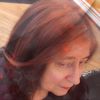Military Archeology 2 in Emotional Numbness
I'm thrilled to announce I'm showing a giclée reproduction at Platform 3 Gallery in Tehran, Iran, exhibition co-sponsored by Women Eco Artists Dialog
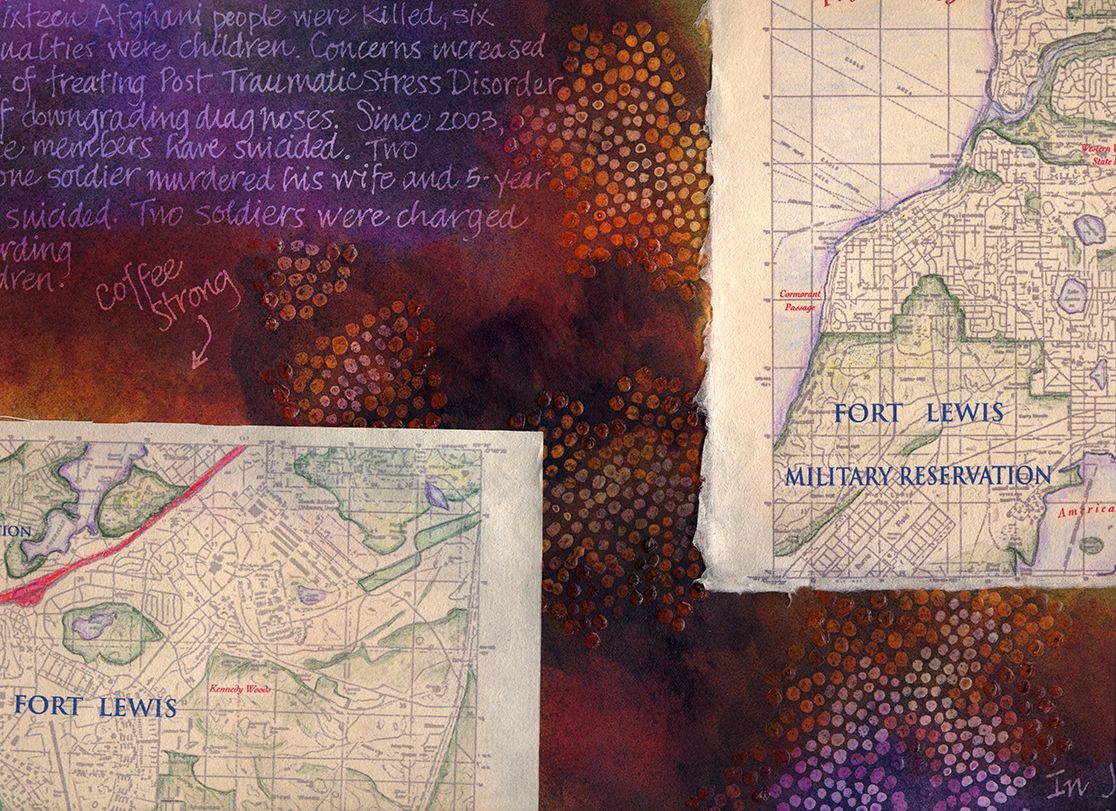
I'm thrilled to announce I'm exhibiting a giclée reproduction of this work at Platform 3 Gallery in Tehran, Iran during an exhibition co-sponsored by Women Eco Artists Dialog, an Oakland CA based artist organization. A detail is represented above, and I've posted a complete image below. This work was previously exhibited in Gwangju, Jeolla Province, Korea, Geummano Metro Gallery, Gwangju Art Museum, 2012
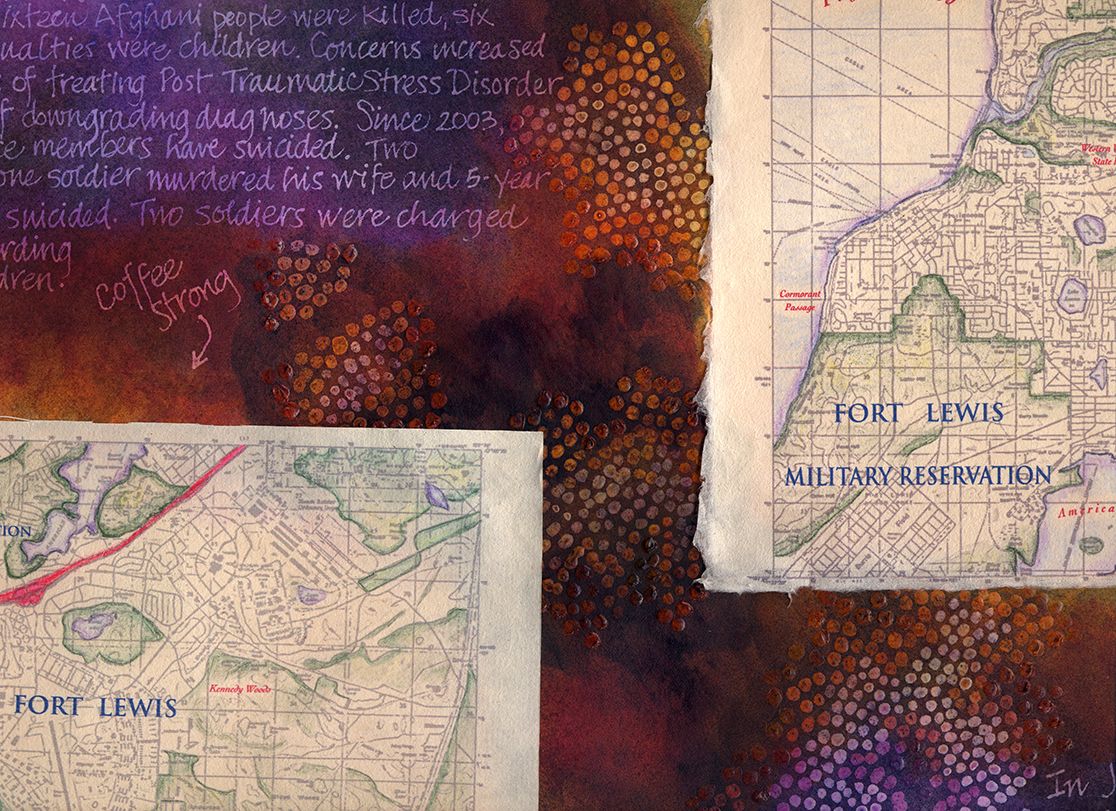
Handwritten text in resist ink consists of geography, social context and history of Joint Base Lewis McChord, now joined as JBLM, in Lakewood, Washington, including anti-war resistance and activist persecution. Reports of domestic violence detailed from Joint Base Lewis McChord are particularly graphic. There are also brief histories of resistance, including Coffee Strong and Port Militarization Resistance, including the base's spying on PMR. Digital maps of USGS grids. Imaging: Art & Soul, Seattle
I will post my statement separately and link it. https://www.planetart.space/statement-for-exhibition-emotional-numbness/
The exhibition is Emotional Numbness: the impact of war on the human psyche and ecosystems, opening September 18 and showing through October 16, 2020 at Platform 3, No. 29, Shahamati alley, north side of Valiasr square, Tehran, Iran. Platform 3 visiting hours are Sunday to Friday, from 17 to 21.
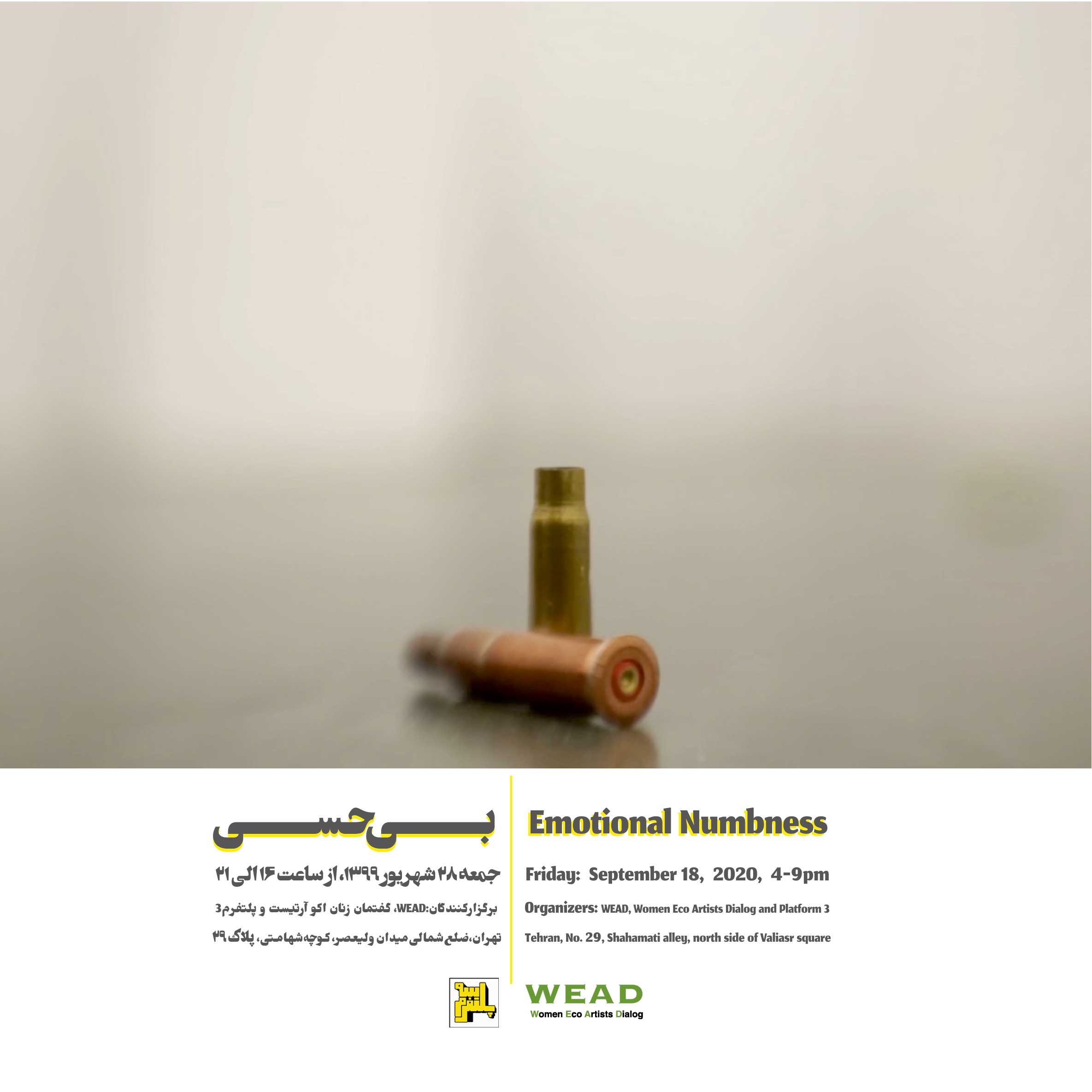
The exhibition focus is the impact of war on ecosystems, and war’s effects on inhabitants of war zones. Recent escalating tensions between Iran and the United States is creating an increase in anxiety about potential war between these countries. Thus, the goal of the exhibition is to create a platform to share, meet, and discuss across borders by exhibiting art which addresses related themes.
The exhibition features the anthropocene epoch, emphasizing the impact of war all around the world, regardless of geographical boundaries. The artists in this exhibit respond to personal experiences of war directly, or through memories inherited from their families, or through environmental research. The works reference the many impacts and challenges of war: displacement, immigration, racial injustice, historical mistakes, numbing of the human psyche, and the invisible enemy that is COVID-19.
The exhibition features the work of 39 artists. Thirty-five artists are showing at Platform 3. Thirty-nine artists will be featured in the online exhibition.
We believe art has the ability to affect perceptions, develop meaningful dialogue, and bring awareness about critical issues to the public. The exhibition has two venues. The primary physical venue is Platform 3, an independent art space run by Iranian artists, located in the center of Tehran, Iran. The secondary venue is online in the 3D virtual gallery space of KUNSTMATRIX. This will be linked to the WEAD (Women Eco Artists Dialog) website.
Platform 3 In-person opening reception: September 18, 2020 4-9pm
ONLINE OPENING
SUNDAY September 27, 4:00-5:00pm PDT
LOCATION: ZOOM
RSVP HERE ON EVENTBRITE
Join us on September 27th for the online opening of Emotional Numbness: The impact of war on the human psyche and ecosystems exhibition. Come discuss the exhibition's artists and theme with other attendees.
Curators: Atefeh Khas www.atefehkhas.com and Minoosh Zomorodinia www.rahelehzomorodinia.com
Instagram: 3platform, http://3-platform.com/
https://www.weadartists.org/
further information: https://www.weadartists.org/
Artists exhibiting at Platform 3 include:
Alice Dubiel, Alicia Escott, Andree Singer Thompson, Annie Albagli, Azin Seraj, Carol Newborg, Christina Bertea, Elizabeth Kenneday, Farzaneh Najafi, Gazelle Samizay & Labkhand Olfatmanesh, Gem Beila Rosenberg, Judith Selby Lang and Richard Lang, Kamala Platt, Katya Grokhovsky, Mana Salehi, Marguerite Elliot, Mary B. White, Michelle Echenique, Michelle Waters, Nadia Skordopoulou, Nanette Wylde, Nazli Abbaspoor, Nooshin Nafici, Pamela Blotner, Revital Katznelson, Rosie Pascoe, Roya Ebtehaj, Salma Arastu, Sara Madandar, Sharon Siskin, Shirin Khalatbari, Shole Asghari, Sue Hettmansperger, Tammy West, and Verona Fonte
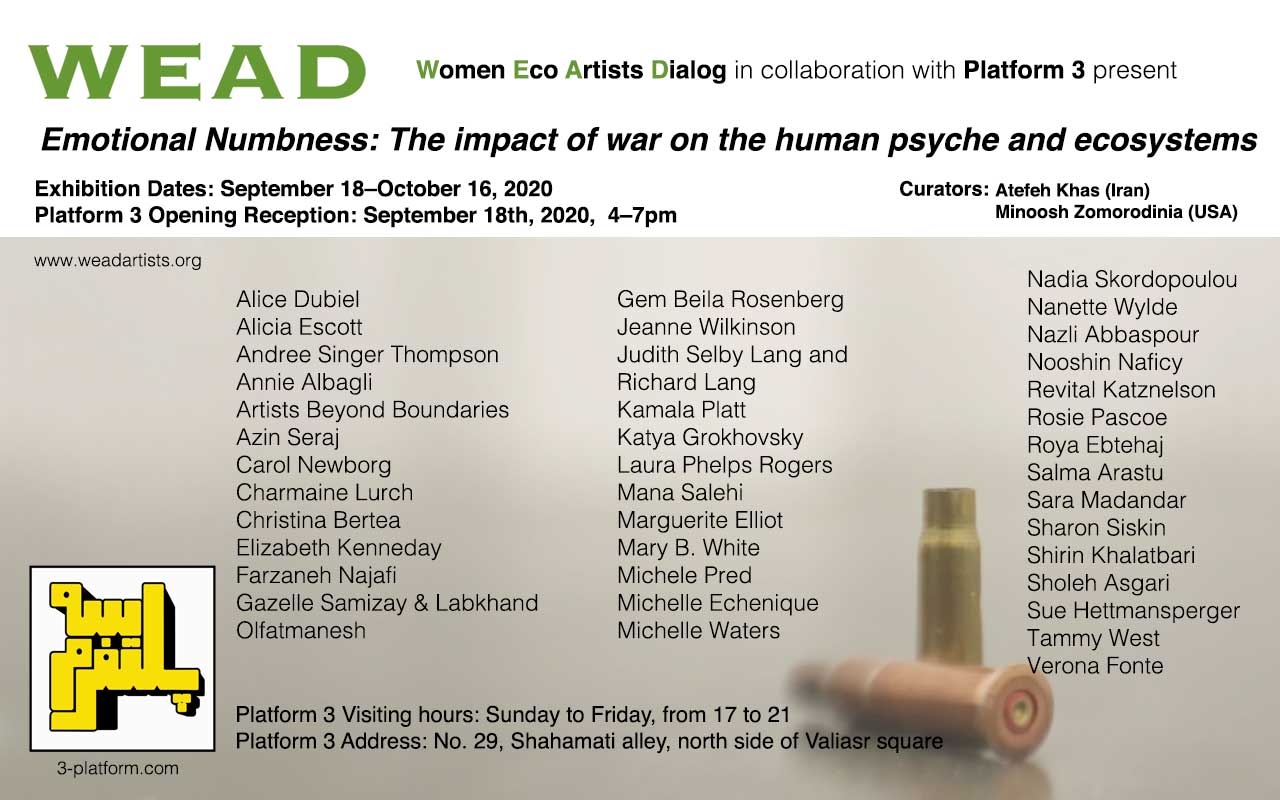
Artists featured in the online exhibition include: Alice Dubiel, Alicia Escott, Andree Singer Thompson , Annie Albagli, Artists Beyond Boundaries, Azin Seraj, Carol Newborg, Charmaine Lurch, Christina Bertea, Elizabeth Kenneday, Farzaneh Najafi, Gazelle Samizay & Labkhand Olfatmanesh, Gem Beila Rosenberg, Jeanne Wilkinson, Judith Selby Lang and Richard Lang, Kamala Platt, Katya Grokhovsky, Laura Phelps Rogers, Mana Salehi, Marguerite Elliot, Mary B. White, Michele Pred, Michelle Echenique, Michelle Waters, Nadia Skordopoulou, Nanette Wylde, Nazli Abbaspoor, Nooshin Nafici, Revital Katznelson, Rosie Pascoe, Roya Ebtehaj, Salma Arastu, Sara Madandar, Sharon Siskin, Shirin Khalatbari, Shole Asghari, Sue Hettmansperger, Tammy West and Verona Fonte.
The text of Military Archeology 2, from the series, Domestic Violence/The War on Terror
Joint Base Lewis-McChord posts 25,000 soldiers and civilian workers, 29,000 family members and services 120,000 retirees. The base covers over 87,000 acres of prime real estate and natural easement in Western Washington. In 1917, this major asset to the US Department of Defense was created by requisitioning property of the indigenous people living on the Nisqually Reservation that bears their name.
The base is named after Meriwether Lewis who co-led an expedition in 1803 from Washington DC to the Columbia river. US Air Force pilot Colonel Wm. Caldwell Mc Chord is the namesake of the military airport.
The Joint Base includes Madigan Hospital, named for Colonel Patrick S. Madigan, known as the father of neuropsychiatry, and the Northwest Joint Regional Correctional Facility. Woodbrook Middle School is located a few blocks north of the base and numerous fast food take away shops are across Interstate 5 Highway at Exit 155. Here, too, is Coffee Strong, a coffee house devoted to soldier support and anti-war resistance at 15109 Union Avenue SW, Lakewood WA 98498, in the tradition of military resistance. There are endless traffic jams and accidents near JBLM. In January 2012, a JBLM soldier murdered a park ranger at Mt. Rainier and suicided.
Rates of violence and crime escalate near the base. Methamphetamine use has increased in Lakewood and surrounding municipalities. Allegations of war stress disparities in treatment at the base arose when we learned that the alleged perpetrator of the Kandahar massacre had been bsed in Ft. Lewis. Sixteen Afghani people were killed, six wounded; 9 casualties were children. Concerns increased that the costs of treating Post Traumatic Stress Disorder are the cause of downgrading diagnoses. Since 2003, 68 base service members have suicided. Two [sic] In April 2011 one soldier murdered his wife and 5-year old child, then suicided. Two soldiers were charged with waterboarding their own children.
In July 2009, John Lowery was outed for spying on anti-war activists for at least 2 years. He was contracted as an US Army informant for a protection unit. In 2007, Lt. Ehren Watada was courtmartialed for his refusal to deploy to Iraq. The first officer to refuse in this war, he was discharged in 2009. Lt. Watada served in Korea before he was stationed at Fr. Lewis. His parents are anti-war activists.
JBLM deploys massive amounts of materiel, now a major export of the US. Items include Stryker vehicles and large transport airplanes, C-17 Globemaster III, made by a division of Boeing, which makes commercial planes in metropolitan Seattle. These planes cost $3.3 million each and each vehicle costs $4.9 million. Transports took place at night.
Beginning in 2004, people protested Ft. Lewis weapons shipments through the civilian Port of Olympia, south of the base. By 2006, Port Militarization Resistance organized to block JBLM military transports through the Port of Tacoma, including the Port of Olympia as well. Stryker vehicles were loaded onto USNS Pomeroy and Soderman.
Protesters were pepper sprayed, shot with rubber bullets tasered, and journalists were detained and denied access. No backpacks were allowed. so activists brought backpacks stuffed with the US Constitution in them.
In July 2012, the FBI invaded activists’ home in Seattle, lympia and Portland, seizing books, computers and telephones. Grand juries have convened as police search for reasons to charge activists.

